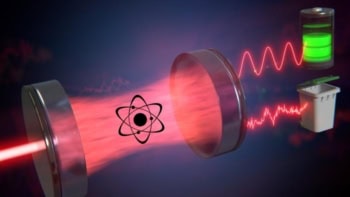An audience of frenzied heavy-metal concertgoers behaves just like molecules in a gas, according to the first-ever study of crowd motion in a “mosh pit”. The work was done by physicists at Cornell University in the US – who claim that a better understanding of the collective motion of the mosh pit in front of a stage could lead to better designed music venues and improved crowd-control tactics. They also believe that the study could be used to reduce the risk of injury or worse during mass evacuations, riots and other “extreme social gatherings”.
Crowds of people exhibit a range of collective behaviours depending on the social context. For example, people walking in opposite directions down a corridor tend spontaneously to separate into two lanes. But when people become panicked, the situation can change significantly and often for the worse. At the 2010 Love Parade festival in Duisburg, Germany, for example, a crowd disturbance escalated into a fatal stampede that left 21 people dead and hundreds more injured. A similar panic during the 2006 Hajj pilgrimage to Mecca claimed 300 lives in the crush.
Understanding crowd dynamics in these extreme situations is critical to avoiding future tragedies. “But we just don’t really understand well how people are going to behave [in these situations] and that’s because we don’t have a lot of experimental data,” explains co-author of the study, Jesse Silverberg, who is a postgraduate student at Cornell. While it would be unethical to engineer a crush in the name of scientific research, asking volunteers to practise stadium evacuations clearly falls short of simulating the blind panic at the crux of real-world disasters.
Messages from the mosh pit
An idea for a more plausible proxy system hit Silverberg when he was at a heavy-metal gig. For many fans, expressing their exuberance at a show involves “moshing” – that is, a form of physical abandon, often violent, characterized by pushing, shoving, pummelling and bouncing off one another. Audience members who want to partake tend to gravitate together to form a “mosh pit” front and centre. Finding himself on the outside looking in, Silverberg was stunned: “I was absolutely amazed by the different types of collective motion that I saw coming out of this group of people,” he recalls.
Together with fellow postgraduate Matt Bierbaum, Silverberg analysed mosh-pit footage from YouTube, correcting for perspective distortions and camera instability before applying particle-image velocimetry techniques to track the flow of bodies. The researchers found that the statistical distribution of the moshers’ speeds replicated that of molecules bouncing round in a 2D gas – the Maxwell–Boltzmann distribution in 2D.
“This is not something that any of us expected,” says Jim Sethna of Cornell, whose statistical-mechanics class inspired the work. The important question facing the team was how could it be that self-propelled moshers crashing together in a system far from thermodynamic equilibrium could collectively resemble the equilibrium state of a gas?
A method to the madness
Seeking answers, the team used standard flocking-simulation software to model the mosh pits. Such models have been around for several decades and were originally created to simulate the collective behaviour of flocks of birds. The model reduces each human entity to a simple particle – a Mobile Active Simulated Humanoid, or MASHer. The researchers included two types of MASHer in a ratio 3:7 in the total group of 500 – those inclined to move round and follow their neighbours (active), and those with a tendency to stay still and hang back (passive). They discovered that when random collisions, as in a gas, were more dominant than the tendency for individuals to follow their neighbours, the simulation resembled a classic mosh pit. However, when they nudged up the tendency to follow or flock, a new structure emerged that was ordered and vortex-like – one that looked intriguingly like the “circle pits” seen at many heavy-metal concerts (see video above).
“You’d think that, like square dancing, you’d need to have a brain to do it, but apparently not,” jokes Sethna. “You can get these circle pits just by making the flocking term a little bigger and the noise a little smaller.” You might also think that sentient beings could be credited for the segregation seen at gigs – where anyone who doesn’t want to get involved either moves away or chooses not to run forwards, resulting in a more stationary crowd surrounding the pit. However, this behaviour appeared in the simulation with the simple addition of the flocking term.
Building a taxonomy of behaviour
Anders Johansson, a crowd-modelling expert at Bristol University in the UK who was not involved with the research, thinks that the work takes an “interesting direction” in a field that has thus far focused on either comparatively calm pedestrian traffic or footage of disasters. “I think this helps towards building a taxonomy of different crowd behaviours in different settings,” he explains.
He adds that incorporating this sort of crowd modelling into architectural design – for example building sports stadia with optimal emergency-escape routes – is already being done. “It’s fitting into all stages – planning, design, even operational aspects during big events – nowadays and it’s starting to be a mature area really,” he says.
Voluntary panic?
What is still not clear, however, is whether mosh-pit studies provide useful information about how crowds behave in situations of genuine panic – given that the participants put themselves into the fray voluntarily.
The Cornell team is hopeful that further tests will show its model parameters to be more widely applicable. Nevertheless, says Stehna, “It’s very cool that a simple model can describe human collective behaviour. That gives us confidence…that if we had data on extreme conditions, we could probably come up with a model that didn’t involve complex strategies. We don’t know that this is definitely possible but it seems much more likely now that mosh pits are described.”
The work is published on the arXiv preprint server.



